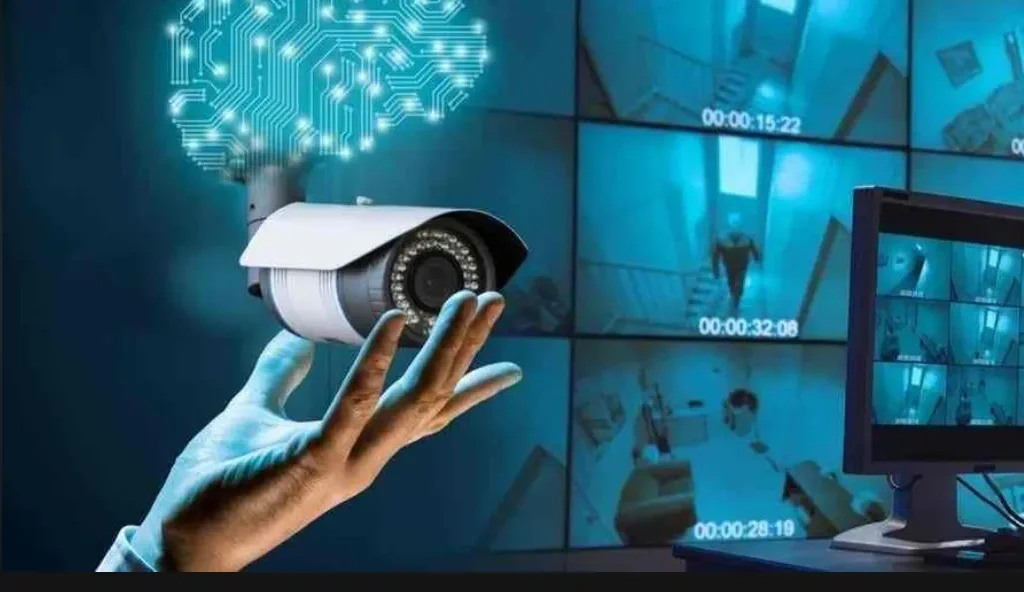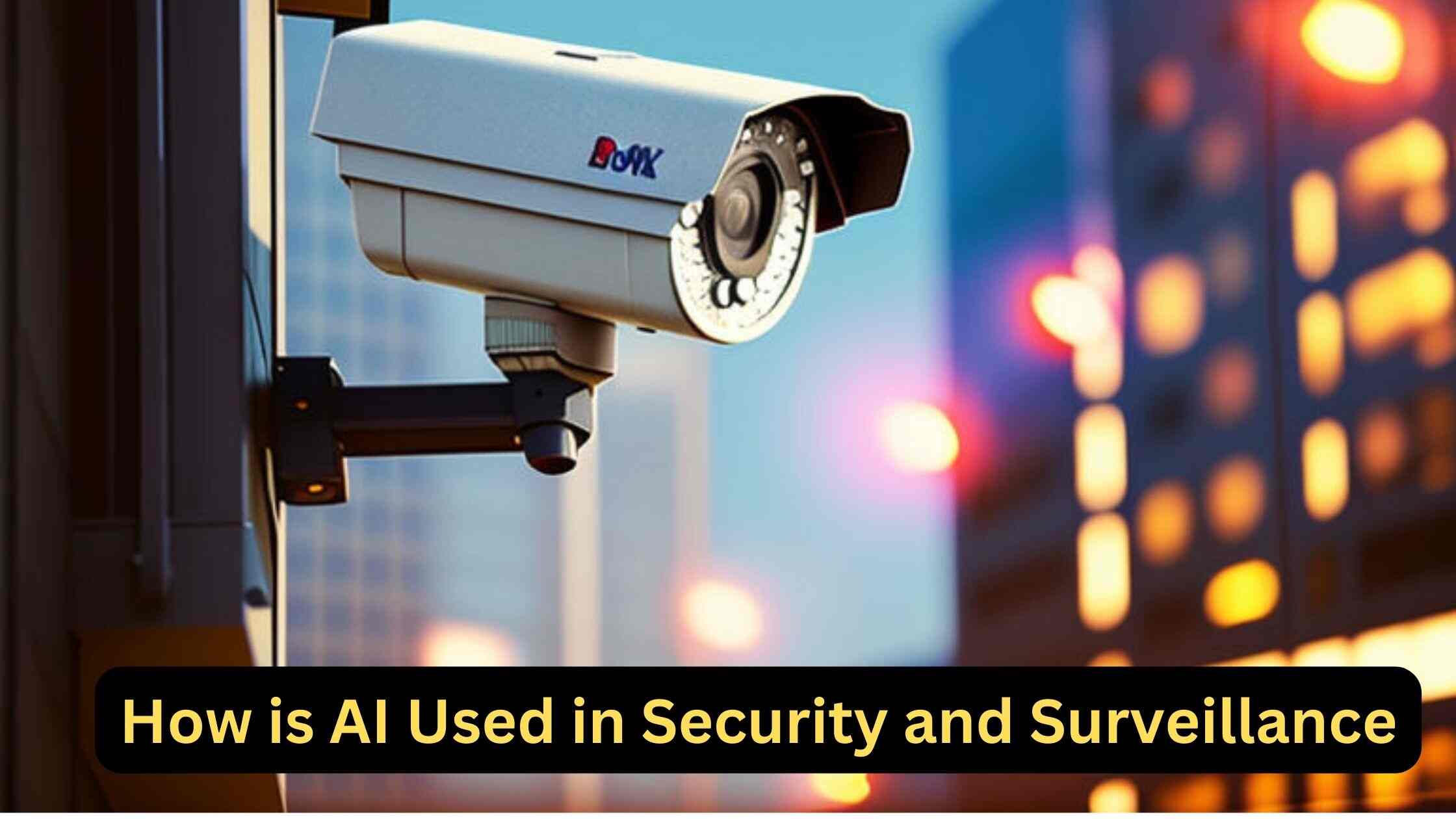In today’s world, keeping places secure is extremely important. This is where AI technology comes in. AI is being used in new and innovative ways for security and surveillance purposes.
AI can analyze video footage, identify potential threats, and alert authorities. It is also applied to improve traditional security methods such as locks and alarms.
In this blog post, we will explain how is AI used in security and surveillance. We’ll cover AI’s role in facial recognition, behavior analysis, and cybersecurity.
Table of Contents
- What is AI in Security and Surveillance?
- AI Applications in Security
- AI Applications in Surveillance
- Challenges and Ethical Considerations
- FAQ’s
- Conclusion
What is AI in Security and Surveillance?

Artificial intelligence (AI), is a type of computer system that can sense their environment, think logically, learn, and take action to achieve specific goals. In security and surveillance, AI plays a major role.
AI systems have the ability to analyze large amounts of data from security cameras, sensors, and other sources. The AI software undergoes training to recognize potential threats or suspicious behavior by analyzing the data it receives.
For example, AI can recognize faces, and detect someone’s suspicious behavior. AI systems can then inform human security workers of any detected dangers.
AI also helps make regular security things like locks and alarms better. It makes them smarter so they can notice possible dangers and react faster.
AI Applications in Security

AI is being used in many important ways to make security systems and procedures better. Here are some of the main applications of AI in security:
Facial Recognition
AI can quickly scan video footage and photos to identify people’s faces. This allows security systems to verify people’s identities and check against databases of known threats.
Object Detection
AI programs can learn to spot specific items like weapons, bags, or vehicles. This helps identify potential threats and risky situations proactively.
Behavior Analysis
AI algorithms can analyze people’s movements and behavior patterns to detect anything suspicious or out of the ordinary. Erratic behavior could indicate a threat.
Video Monitoring
AI acts as an ultra-intelligent video monitoring system, watching all camera footage simultaneously. It can identify risks much faster than human security professionals.
Access Control
AI facial recognition and behavior analysis allow smarter, more responsive access control systems. Access is granted only to authorized individuals and approved activities.
Overall, AI offers highly sophisticated and consistent monitoring capabilities. It automates the process of identifying potential risks based on video, data analysis, and programmed rules. AI makes security systems more comprehensive and effective.
AI Applications in Surveillance

Surveillance is all about closely monitoring an area to detect any potential threats or risks. AI enhances surveillance capabilities in powerful ways:
Video Analytics
AI can analyze video feeds from security cameras to automatically identify people, vehicles, objects, and any unusual behavior or activities. This allows monitoring large areas 24/7.
Facial Recognition
AI facial recognition software can identify people caught on surveillance cameras by matching faces against databases of known individuals. This is useful for tracking suspects.
Pattern Analysis
AI can spot patterns and differences from regular activities by watching an area for a while. Anything strange gets labeled as potentially suspicious.
Predictive Surveillance
By learning from huge datasets, AI can start to predict when and where incidents may occur. This allows for better allocation of surveillance resources.
Data Integration
AI ties together different data streams from cameras, sensors, social media, and more to provide unified real-time surveillance monitoring.
Overall, AI gives surveillance systems enhanced vision, analytics, and integrated data processing. Police and security agencies can watch over larger areas with greater effectiveness using AI surveillance capabilities.
Challenges and Ethical Considerations
While AI offers powerful capabilities for security and surveillance, there are also some challenges and ethical concerns surrounding its use:
Privacy Issues
The constant monitoring and facial recognition aspects of AI surveillance raise privacy issues for individuals. There are fears of overreach or misuse of this technology.
Bias Concerns
When the information used to train AI systems includes human biases, those biases might become part of the AI algorithms. This could lead to discrimination issues.
Error Rates
Even the best AI has a degree of potential errors, false positives, or missed risks. Relying too much on AI could be risky if it makes errors.
Lack of Human Context
AI may sometimes lack important human context or judgment capabilities when assessing situations. This could result in misinterpretations.
Adversarial Attacks
There are concerns that bad actors could try to deceive or manipulate AI security systems through various adversarial techniques.
Regulation Gaps
Laws and regulations around the appropriate use of AI surveillance capabilities have not yet fully caught up in many cases.
Overall, while AI provides enhanced security, its use raises complex ethical questions around privacy, bias, errors, human oversight, and governance that need careful weighing.
FAQ’s
Facial recognition AI detects and measures unique patterns in facial features from images/videos and matches them against a database.
AI systems can potentially be vulnerable to adversarial attacks aimed at fooling or bypassing their algorithms through deceptive inputs.
AI surveillance usually learns from big sets of security videos, sensor info, and records of past incidents to spot risks accurately.
Conclusion
In conclusion, AI plays an important role in security and surveillance. From facial recognition and behavior analysis to predictive monitoring and adversarial detection, AI enhances our ability to identify potential threats. While challenges around privacy, bias, and ethics need ongoing consideration, the future of AI used in security and surveillance systems will likely continue growing to make our public spaces and digital realms safer.


4 thoughts on “How is AI Used in Security and Surveillance? (Class 8)”